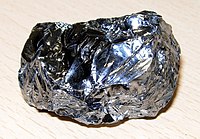
Photo from wikipedia
Abstract The mechanism governing the production of the paramagnetic [AlO4/h+]0 centres (denoted also as Al-hole or Al-h) in quartz as a function of given dose is of great importance in… Click to show full abstract
Abstract The mechanism governing the production of the paramagnetic [AlO4/h+]0 centres (denoted also as Al-hole or Al-h) in quartz as a function of given dose is of great importance in electron spin resonance (ESR) dating, as the analytical function used to characterise the evolution of this centre with accumulated dose is used to derive the equivalent dose by extrapolation to the abscissa-axis. The single saturating exponential model fails to accurately represent the dose response curve especially at high doses, and consequently, empirical functions, such as a saturating exponential plus a linear term, are widely used in the dating community. Herein, a physical phenomenological model is presented to describe the Al-hole formation under gamma irradiation in sedimentary quartz. Based on previous studies it is known that the Al-hole centre is formed via the dissociation of the Al centres compensated with alkali ions [AlO4/M+]0 (generally denoted as Al-M) where M+ could be Li+, Na+ or K+, as well as by the dissociation of Al compensated with hydrogen ions [AlO4/H+]0, (denoted as Al–H). When irradiation moves interstitial alkali ions away from the aluminium ions, they can be replaced by H+ ions beside the conversion to Al-hole centres. By assuming that the rate of the dissociation process is proportional to the concentration of the defects themselves, a sum of saturating exponential functions is obtained for describing the growth of Al-hole with dose. The model is applied on data obtained on sedimentary quartz specimens of different origins for describing the dose response of the paramagnetic Al-hole ESR signal. We are showing that the signal of Al-hole does not reach full saturation at doses even as high as 100 kGy and can it be well represented by two exponential components as predicted by the model. As such, the additional linear term reported by other works when describing the dose response is just a first order approximation of one of the saturating exponential functions.
Journal Title: Radiation Measurements
Year Published: 2020
Link to full text (if available)
Share on Social Media: Sign Up to like & get
recommendations!